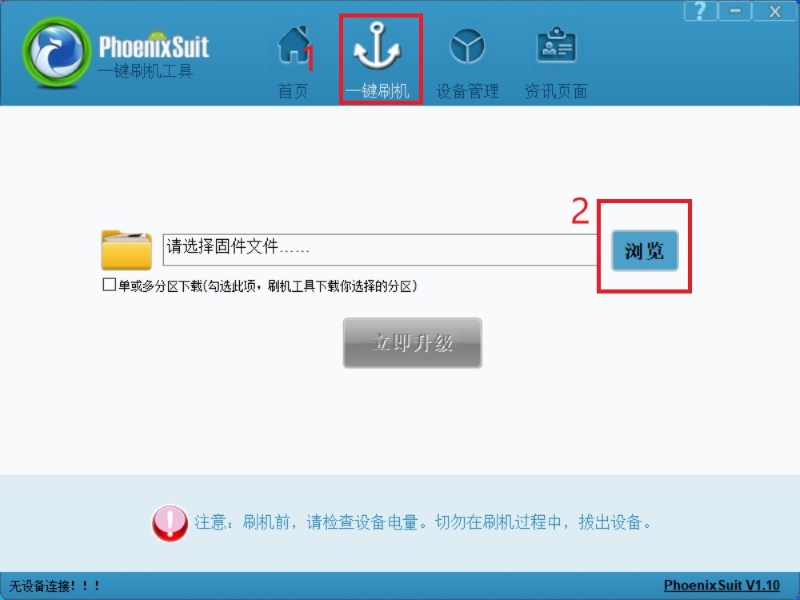
¶ Introduction
| More Infomation: Banana Pi BPI-M4_Zero |
¶ Android
¶ Prepare
-
Download latest Android image.
-
Download and Install Allwinner Image Download Tools, PhoenixSuit is for window.
-
Type-C cable, 5V power supply.
¶ Install Image with USB tool
-
Open PhoenixSuit, click the Firmware icon to switching to firmware download panel, then click Image button and choose the Android Image file.

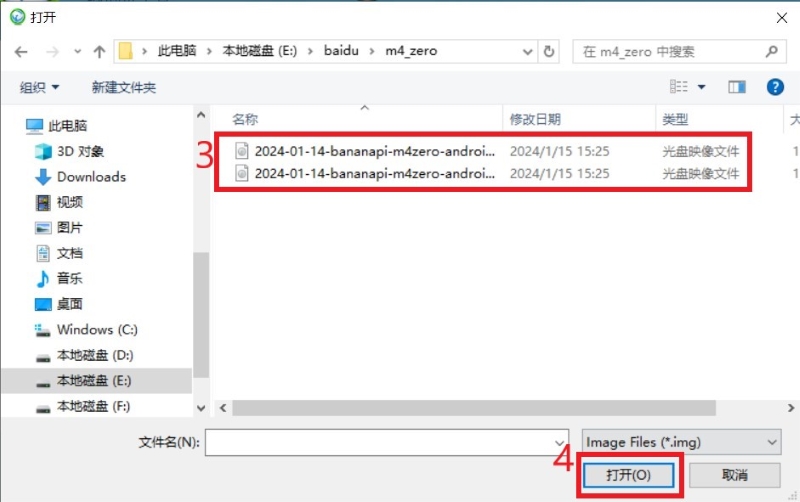
-
Press and hold the SW2 button on M4 Zero while connecting to the computer using type-c, popup a warning dialog.Press Yes.

-
Download
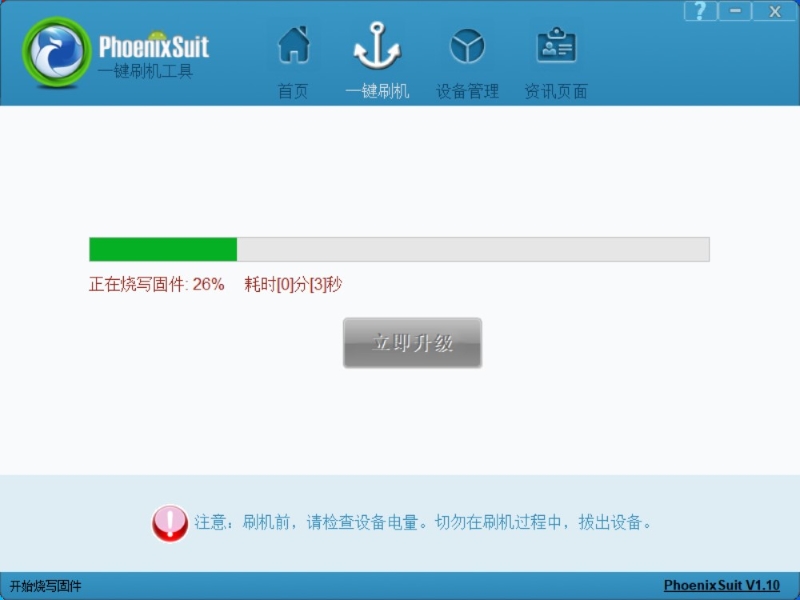
-
Download finish
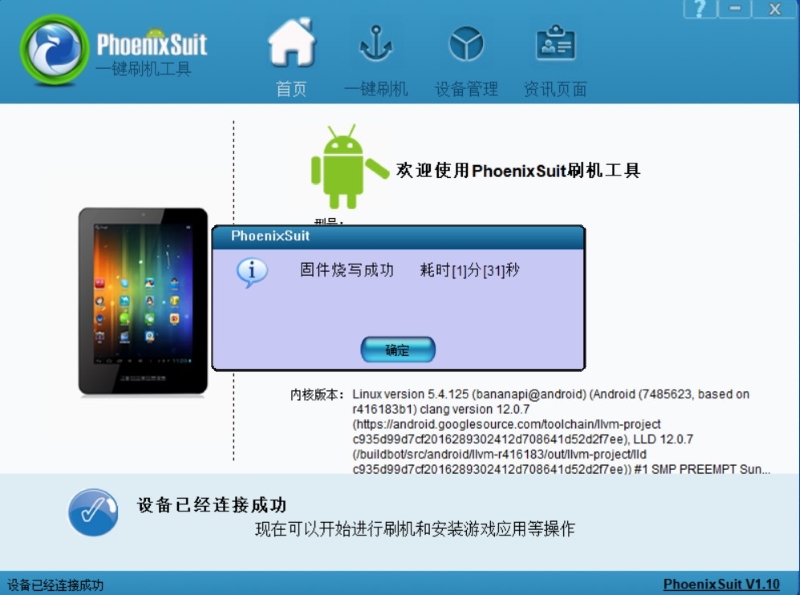
¶ Linux
¶ Prepare
-
Linux image support SDcard or EMMC bootup, and will boot from the SD card first.
-
It’s recommended to use A1 rated cards, 8GB at least.
-
Make sure bootable EMMC is formatted if you want bootup from SDcard.
-
Make sure SDcard is formatted without Linux image flashed if you want bootup from EMMC and use Sdcard as storage.
-
Download latest [Linux Linux Image], and confirm that the md5 checksum is correct.
-
Default login: pi/bananapi or root/bananapi
-
The wiki guide is only for [bananapi 4.9 bsp ubuntu/debian images].
¶ Install Image to SDcard
Windows
Balena Etcher is an opensource GUI flash tool by Balena, Flash OS images to SDcard or USB drive.
-
Click on "Flash from file" to select image.
-
Click on "Select target" to select USB device.
-
Click on "Flash!" Start burning.
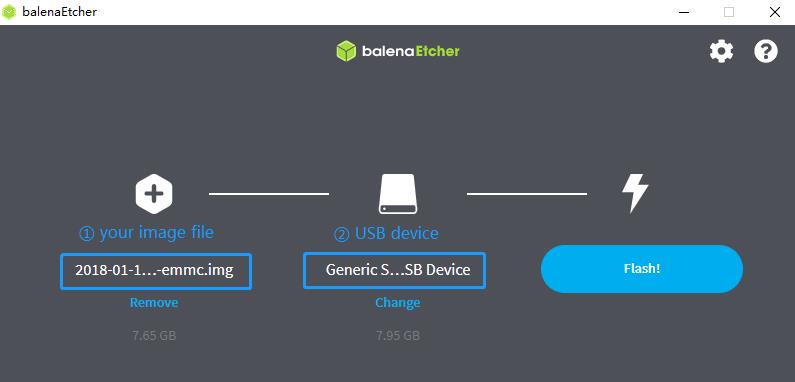
¶ Use dd command to burn to eMMC
-
Copy the img file to the USB drive and insert it into the M4 ZERO.
-
Execute:
root@bpi-m4zero:~# lsblk NAME MAJ:MIN RM SIZE RO TYPE MOUNTPOINTS sda 8:0 1 961M 0 disk mmcblk1 179:0 0 14.8G 0 disk └─mmcblk1p1 179:1 0 14.7G 0 part /var/log.hdd / mmcblk0 179:16 0 7.3G 0 disk ├─mmcblk0p1 179:17 0 32M 0 part ├─mmcblk0p2 179:18 0 32M 0 part ├─mmcblk0p3 179:19 0 256K 0 part ├─mmcblk0p4 179:20 0 256K 0 part ├─mmcblk0p5 179:21 0 64M 0 part ├─mmcblk0p6 179:22 0 64M 0 part ├─mmcblk0p7 179:23 0 32M 0 part ├─mmcblk0p8 179:24 0 32M 0 part ├─mmcblk0p9 179:25 0 3G 0 part ├─mmcblk0p10 179:26 0 16M 0 part ├─mmcblk0p11 179:27 0 128K 0 part ├─mmcblk0p12 179:28 0 128K 0 part ├─mmcblk0p13 179:29 0 64K 0 part ├─mmcblk0p14 179:30 0 64K 0 part ├─mmcblk0p15 179:31 0 64K 0 part ├─mmcblk0p16 259:0 0 64K 0 part ├─mmcblk0p17 259:1 0 512K 0 part ├─mmcblk0p18 259:2 0 15M 0 part ├─mmcblk0p19 259:3 0 16M 0 part ├─mmcblk0p20 259:4 0 16M 0 part ├─mmcblk0p21 259:5 0 2M 0 part ├─mmcblk0p22 259:6 0 2M 0 part ├─mmcblk0p23 259:7 0 16M 0 part ├─mmcblk0p24 259:8 0 16M 0 part └─mmcblk0p25 259:9 0 3.9G 0 part mmcblk0boot0 179:32 0 4M 1 disk mmcblk0boot1 179:48 0 4M 1 disk zram0 254:0 0 982.5M 0 disk [SWAP] zram1 254:1 0 50M 0 disk /var/logmount /dev/sda /mntAfter the mount is complete, open the
cdfile. Thelscommand will show the img file you want to burn.cd /mnt ls -
Then use the dd command to burn the file.
sudo dd if=20241011_Bananapi-Armbian_24.8.2_Bpi-m4zero_ubuntu22.04_jammy_legacy_5.4.125_minimal.img of=/dev/mmcblk0
¶ Install Image to eMMC
-
Make sure that the Linux image has been burned into an SD card and started normally.
-
Enter the following command in the terminal.
sudo bananapi-config -
Follow the instructions below to install the Linux system image on the eMMC.
-
Select
Ststem.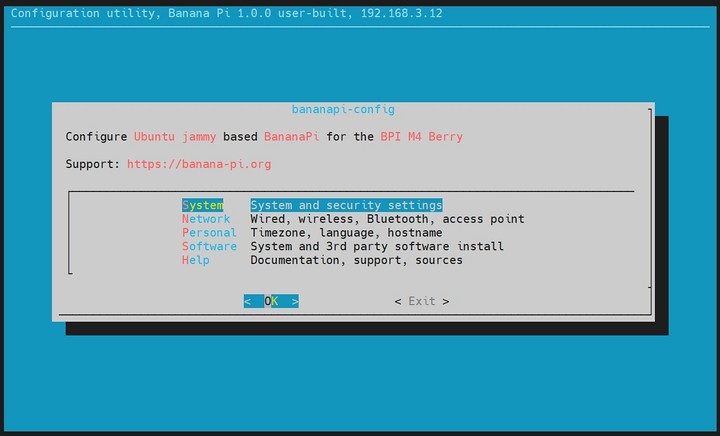
-
Select
Install.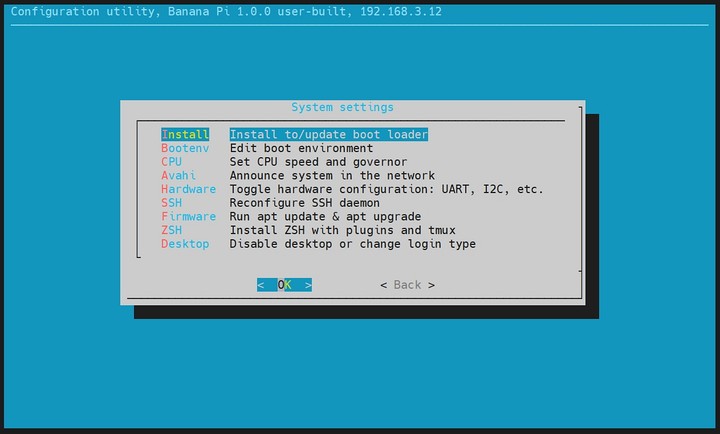
-
Select
Boot from eMMC.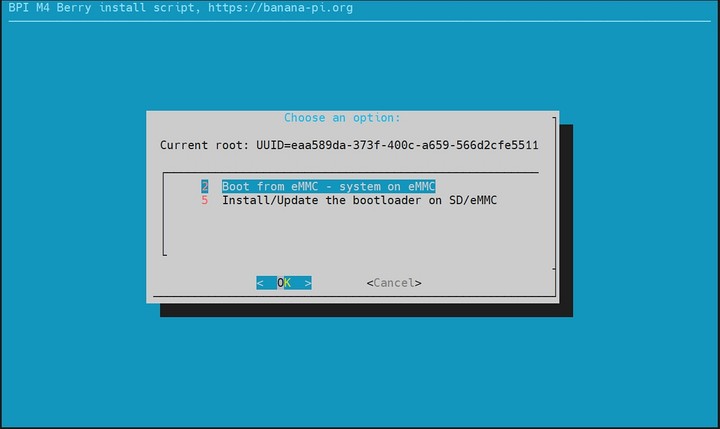
-
Select
Yes.
-
Select
ext4.
-
Wait a few minutes. Do not power off or restart the board at this time.
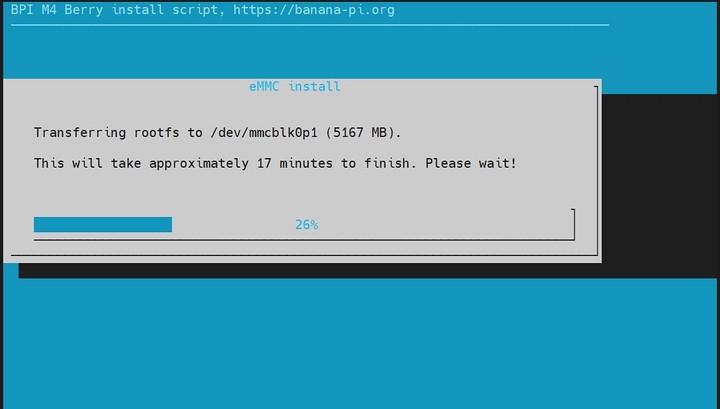
-
The last step is to shut down the board. At this time, disconnect the power supply, remove the SD card, and connect the power again, to boot from eMMC.
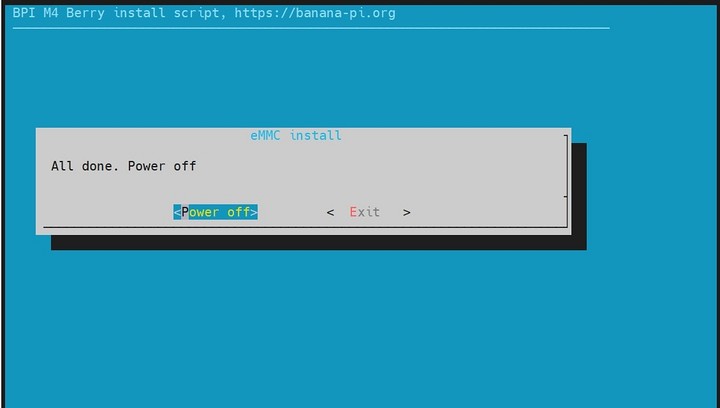
-
¶ Ubuntu Desktop
-
Using the Ubuntu desktop version system image, you can get a graphical operation interface.
-
You need to prepare a monitor with an HDMI interface, an HDMI cable, and a mini HDMI to HDMI adapter.
-
Use an HDMI cable and a mini HDMI to HDMI adapter to connect the monitor and BPI-M4 Zero, switch the monitor input interface to the corresponding HDMI interface, power on, and wait a moment to see the desktop.

¶ Debug UART
-
Prepare a 3.3v USB to TTL module.
-
Use the USB to TTL module to connect the PC USB port and the Debug UART port on the board.
-
Open a serial terminal software on the PC, such as mobaxterm or putty.
-
Taking mobaxterm as an example, after setting the serial port number and 115200 baud rate, you can open the BPI-M4 Zero UART terminal.
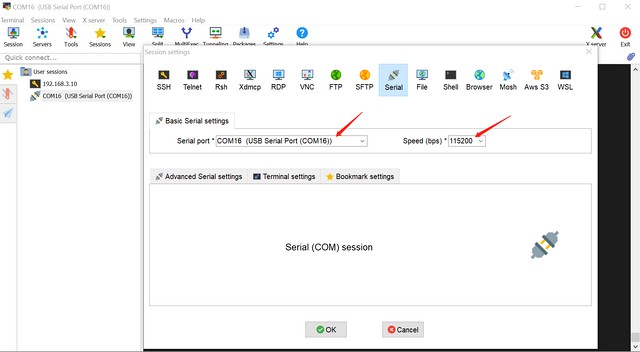
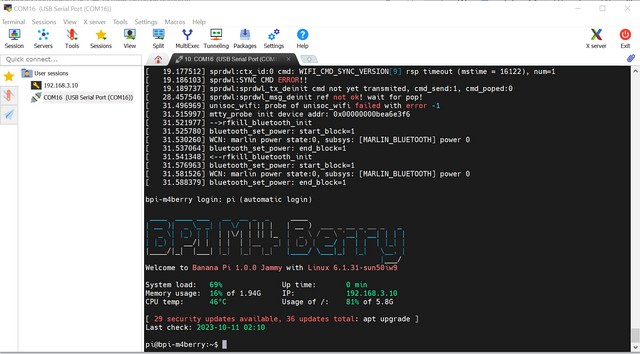
¶ SSH
-
Prepare a network cable and a router.
-
Use a network cable to connect the LAN port of the router to the BPI-M4 Zero, and also connect the PC to another LAN port.
-
Check the IP address of BPI-M4 Zero on the router management interface, or use the following command on the BPI-M4 Zero UART terminal to check the IP address.
ifconfigeth0: flags=4163<UP,BROADCAST,RUNNING,MULTICAST> mtu 1500 inet 192.168.3.10 netmask 255.255.255.0 broadcast 192.168.3.255 inet6 fe80::3e1f:688f:81ab:d8b7 prefixlen 64 scopeid 0x20<link> ether 02:00:54:a0:d6:a6 txqueuelen 1000 (Ethernet) RX packets 553 bytes 92549 (92.5 KB) RX errors 0 dropped 0 overruns 0 frame 0 TX packets 329 bytes 26023 (26.0 KB) TX errors 0 dropped 0 overruns 0 carrier 0 collisions 0 device interrupt 42 -
Open an SSH terminal software on the PC, such as mobaxterm or putty.
-
Taking mobaxterm as an example, fill in the obtained IP address, such as 192.168.3.10 above, in the IP address column and 22 in the Port port.
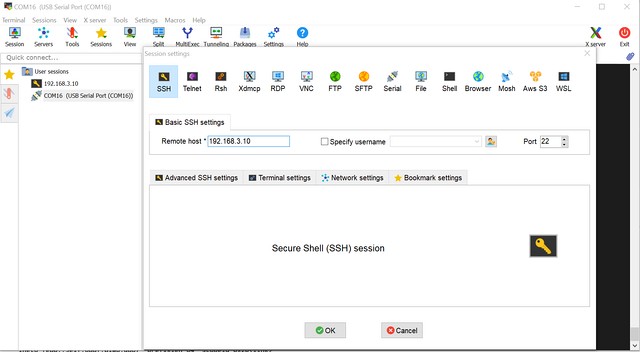
-
Open the SSH terminal and enter the login username/password: pi/bananapi or root/bananapi. There will be no prompt when entering the password. Please enter it normally and press Enter when finished.

¶ NoMachine Remote Desktop
-
Make sure BPI-M4 Zero is connected to the Internet and use the following command to download the nomachine DEB installation package in the system.
wget https://download.nomachine.com/download/8.9/Arm/nomachine_8.9.1_1_arm64.deb -
Or open NoMachine for ARM - arm64 download page in a PC browser, download the DEB installation package, and then copy it to BPI-M4 Zero user directory through SSH or USB disk.
-
After the download is completed, install it through the following command. Note that the file name is based on the actual downloaded file name.
sudo dpkg -i nomachine_8.9.1_1_arm64.deb -
PC side also needs to download and install NoMachine. NoMachine download page Select the installation package suitable for the PC operating system, download it locally and complete the installation.
-
Pay attention to keeping the PC and BPI-M4 Zero in the same LAN. You can try SSH connection first to ensure normal communication within the LAN.
-
Open NoMachine on the PC, click the Add button, enter the IP address of BPI-M4 Zero in the Host bar in the window after the jump, and then click the Add button.

-
Click the recognized port icon, enter the username/password in the new window that pops up, and then click the OK button.
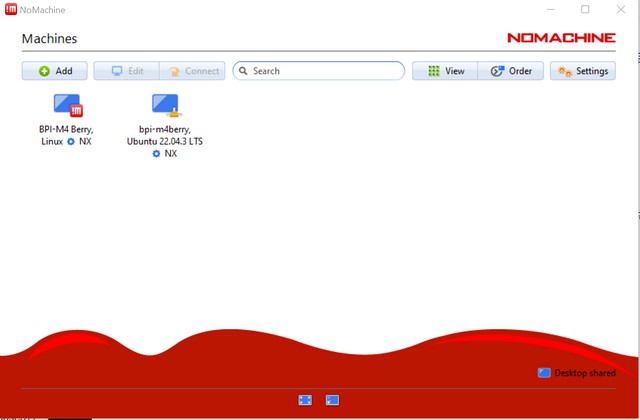
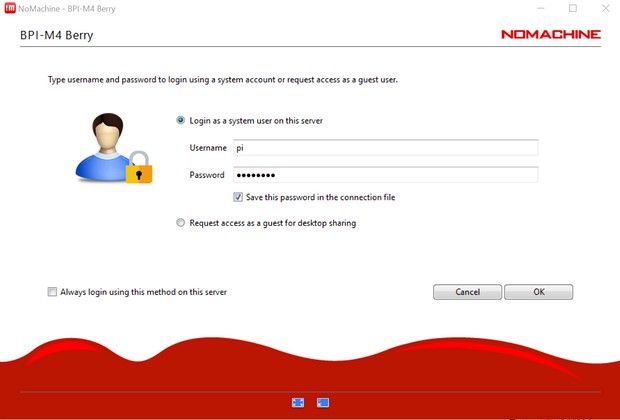
-
After completing the subsequent settings, you can see the desktop.
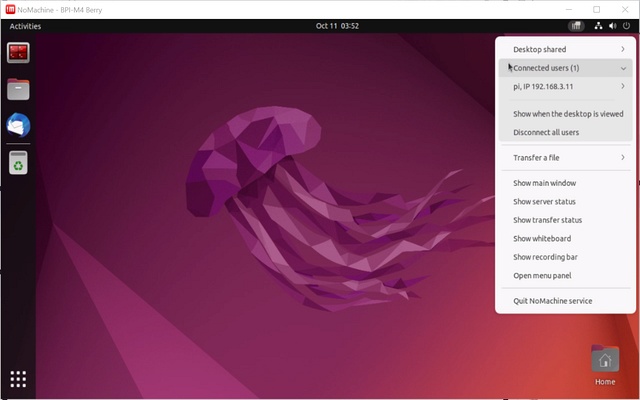
-
If no device is connected to the HDMI interface, the NoMachine remote desktop will display a black screen. It is recommended to keep the HDMI connection or connect an HDMI decoy device.
¶ WiFi
Use the nmcli command to scan WiFi hotspots, connect to hotspots, and create AP hotspots.
nmcli device
nmcli device wifi list
nmcli device wifi connect [SSID] password [PASSWORD]
nmcli device disconnect [device name]
nmcli device wifi hotspot con-name [NAME] ifname [device name] ssid [SSID] password [PASSWORD] nmcli connection show
nmcli connection down [NAME]
nmcli connection up [NAME]
nmcli connection delete [SSID] nmcli radio wifi off
nmcli radio wifi on¶ Set static IP, DNS
-
To set a static IP, you need to maintain the connection first. If you want to set an Ethernet static IP, you must first maintain the Ethernet connection; if you want to set a wireless network static IP, you must first maintain a connection to a WIFI.
-
If the upper-level router has assigned the IP address you want to set to other devices, please change it to an idle IP, or ask other devices to give up the IP.
-
Use the nmcli connection show command to display all connections, for example:
pi@bpi-m4zero:~$ nmcli connection show NAME UUID TYPE DEVICE TP-LINK_5G_7747 e4a49726-adf1-44d7-a621-0e3af96cc390 wifi wlx2cc3e6acd5d7 Wired connection 1 612eda94-55dc-3c85-b05e-f16c41775b4e ethernet -- -
Use the nmcli connection show [NAME] command to display all the properties of a specific connection, such as:
nmcli connection show TP-LINK_5G_7747If you want to see Ethernet, change to Wired connection 1
Only list three common items
ipv4.dns: 192.168.3.1 ipv4.addresses: 192.168.3.10/24 ipv4.gateway: 192.168.3.1-
The default is the gateway address
-
The default is the IP address assigned by the router DHCP
-
Gateway address, the default is the IP address of the router
-
-
Set static IP:
nmcli connection modify TP-LINK_5G_7747 ipv4.addresses 192.168.3.2 -
Set DNS:
nmcli connection modify TP-LINK_5G_7747 ipv4.dns 8.8.8.8 -
Reset:
reboot -
After restarting, check whether the modification is successful:
ifconfig nmcli connection show TP-LINK_5G_7747
¶ Network time synchronization
Chrony is an open source free Network Time Protocol NTP client and server software. It allows the computer to keep the system clock synchronized with the clock server (NTP), thus allowing your computer to maintain accurate time. Chrony can also be used as a server software to provide time synchronization services for other computers.
timedatectl set-ntp false sudo apt install chrony
systemctl start chrony
systemctl enable chrony
systemctl status chrony
systemctl restart chrony timedatectl status
timedatectl list-timezones
timedatectl set-timezone Asia/Shanghai
timedatectl set-ntp true date
sudo hwclock -r¶ View hardware temperature
Enter the following command to view the temperature data returned by the sensor built into the chip on the BPI-M4 Zero board.
sensors¶ Modify HDMI output resolution
When using the Ubuntu desktop operating system, you can find the Displays column in Settings and modify the resolution.
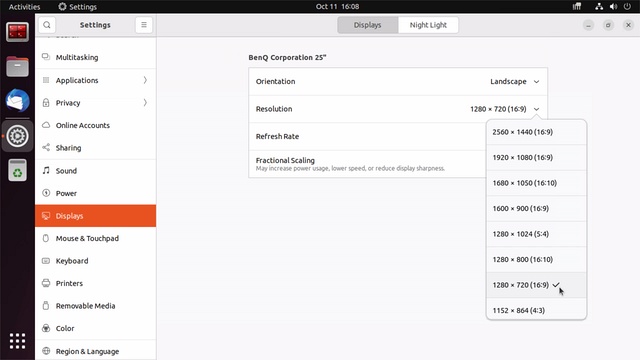
¶ Use USB disk
-
Prepare a USB disk that has been partitioned normally and insert it into the USB interface of BPI-M4 Zero.If it is a USB disk with a type-A plug, you also need a type-A to type-C adapter.
-
In the Ubuntu desktop version, you can see that the USB disk has been recognized and can be opened in the file manager, or partition management can be performed through the GParted tool.
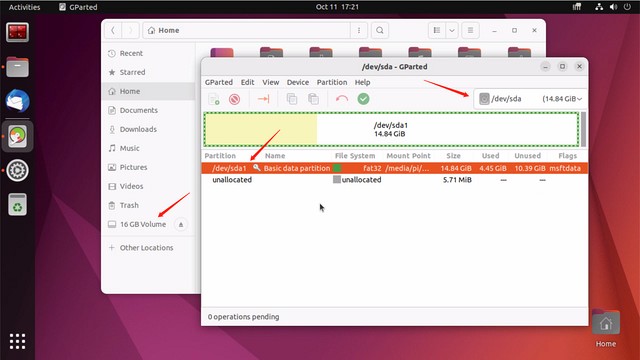
-
In the terminal, mount the USB disk to the local directory:
mkdir mnt cat /proc/partitions | grep "sd*" sudo mount /dev/sda1 ~/mnt/ ls ~/mnt/ sudo umount -v /dev/sda1
¶ Use Audio Devices
Prepare an audio file and copy it to the BPI-M4 Zero Ubuntu desktop system through a USB flash drive or SSH.
HDMI audio
-
Prepare a monitor with HDMI audio input function, turn on the relevant functions in the monitor settings, use an HDMI cable and a mini HDMI to HDMI adapter to connect the monitor.
-
Set the output device to HDMI Audio in the Sound column of the settings.
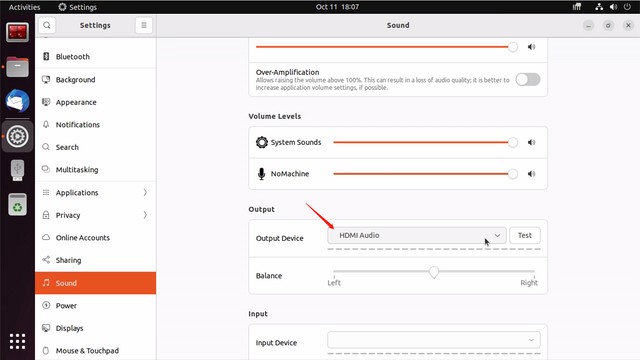
-
Play audio.
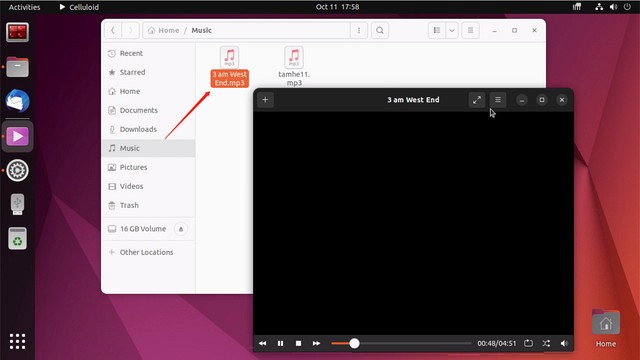
¶ Use Bluetooth
-
Open settings in the Ubuntu desktop and connect a Bluetooth device, such as a Bluetooth mouse or keyboard, in the Bluetooth bar.
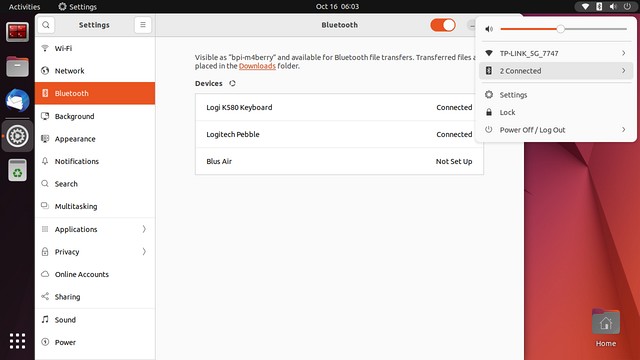
-
The method to connect the Bluetooth device through the command line in the terminal is as follows:
pi@bpi-m4zero:~$ sudo bluetoothctl [sudo] password for pi: Agent registered [CHG] Controller 2C:C3:E6:AC:D5:D8 Pairable: yes [bluetooth]# power on Changing power on succeeded [bluetooth]# discoverable on Changing discoverable on succeeded [CHG] Controller 2C:C3:E6:AC:D5:D8 Discoverable: yes [bluetooth]# pairable on Changing pairable on succeeded [bluetooth]# scan on Discovery started [CHG] Controller 2C:C3:E6:AC:D5:D8 Discovering: yes [NEW] Device D4:C4:85:A5:C6:B1 Logitech Pebble [CHG] Device D4:C4:85:A5:C6:B1 TxPower: 4 [bluetooth]# pair D4:C4:85:A5:C6:B1 Attempting to pair with D4:C4:85:A5:C6:B1 [CHG] Device D4:C4:85:A5:C6:B1 Connected: yes [DEL] Device A4:C1:38:9B:F6:FD SLPO20N20200059 [CHG] Device D4:C4:85:A5:C6:B1 UUIDs: 00001800-0000-1000-8000-00805f9b34fb [CHG] Device D4:C4:85:A5:C6:B1 UUIDs: 00001801-0000-1000-8000-00805f9b34fb [CHG] Device D4:C4:85:A5:C6:B1 UUIDs: 0000180a-0000-1000-8000-00805f9b34fb [CHG] Device D4:C4:85:A5:C6:B1 UUIDs: 0000180f-0000-1000-8000-00805f9b34fb [CHG] Device D4:C4:85:A5:C6:B1 UUIDs: 00001812-0000-1000-8000-00805f9b34fb [CHG] Device D4:C4:85:A5:C6:B1 UUIDs: 00010000-0000-1000-8000-011f2000046d [CHG] Device D4:C4:85:A5:C6:B1 ServicesResolved: yes [CHG] Device D4:C4:85:A5:C6:B1 Paired: yes Pairing successful #pairing successfully [CHG] Device D4:C4:85:A5:C6:B1 Modalias: usb:v046DpB021d0007 [bluetooth]# exit pi@bpi-m4zero:~$
¶ Transfer files
scp
scp (secure copy) command in Linux system is used to copy file(s) between servers in a secure way.
The SCP command or secure copy allows the secure transferring of files between the local host and the remote host or between two remote hosts.
It uses the same authentication and security as it is used in the Secure Shell (SSH) protocol.
You can copy files from a Windows terminal to a Linux system on the same LAN. Just make sure the Open SSH client is turned on and can be viewed in Settings > Applications > Optional Features.
If you want to copy files from Windows systems to Linux systems, you also need to enable the Open SSH server.

The scp command format is:
scp [optionals] file_source file_target-
[optionals] is an optional parameter, such as -r, which can be used to copy the entire directory recursively.
-
file_source The file or directory to be copied.
-
file_target will copy the past path and rename it if a specific file name is entered at the end.
Take copying local files from a Windows system to a Linux system as an example. In the Windows terminal, enter:
PS D:\temp\temp_4> scp ".\hello.txt" [email protected]:"/home/pi/Downloads/"You can also copy files in the Linux system to the local computer in the Windows terminal:
PS D:\temp\temp_4> scp [email protected]:"/home/pi/Downloads/hello.txt" "D:\temp\temp_4"-
Where [email protected] is the user name in the Linux system and the IP address of the BPI-M4 Zero in the LAN.
-
Where :"/home/pi/Downloads/hello.txt" is the file path in the Linux system.
-
Where "D:\temp\temp_4" is the path in Windows system. scp reference document
mobaxterm
Files can be managed through a graphical interface using mobaxterm or other similar software.
As shown in the figure below, after establishing an SSH connection in mobaxterm, a file management window will appear on the left side of the interface, which supports copying and pasting by dragging and dropping files.
